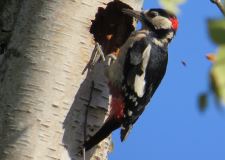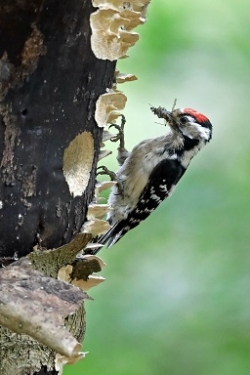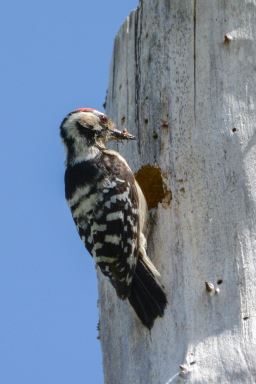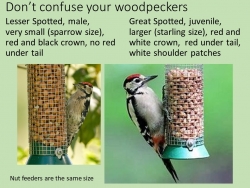It is great to see the coverage of nesting Great Spotted Woodpeckers in BBC Springwatch – they are brilliant birds.
We were interested to see that the woodpecker holes in the Scots Pines in Abernethy Forest tend to be orientated to the northeast. Our long-term studies of Great Spotted Woodpeckers in oak woodlands in Hertfordshire, southern England (see for instance Smith 2007) show a similar pattern even though the nest tree species and location are different from Abernethy.
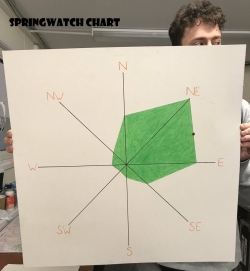 Springwatch GSW nest orientation chartFor the 821 nest trees used between 1984 and 2016 we find a small but statistically significant bias for the holes to be facing northeast – the mean direction being 40 degrees east of north.
Springwatch GSW nest orientation chartFor the 821 nest trees used between 1984 and 2016 we find a small but statistically significant bias for the holes to be facing northeast – the mean direction being 40 degrees east of north.
However, when we look in detail at the data, the effect is quite subtle.
Great Spotted Woodpeckers place their nests in both live and dead trees, sometimes in the tree trunk and sometimes in larger limbs on the trees. We find there is no overall selection for any particular orientation for nest holes in limbs or live trees, but the nest holes in dead trees are strongly orientated to the northeast.
Our explanation for this is that woodpeckers often place their nest cavity on the underside of the trunk or branch presumably for protection against adverse weather. Dead trees will tend to lean away from the prevailing wind which in southern England is from the southwest. Hence the holes are likely to face northeast.
We are looking for someone to invent a gizmo for us to measure the lean of the tree at the actual nest site high in the tree to prove our explanation!
It is not clear whether similar factors are operating in Abernethy but, as we understand it, most of the excavations are in live Scots Pines.
Is there any tendency for them to lean away from the prevailing wind direction?
In a review of nest orientation in woodpeckers around the world, Jeff Walters and colleagues (Landler et al. 2014) concluded there was often evidence of selection for particular directions and that this was most likely related to regional climatic conditions such as wind, rainfall and sunshine.
Ken Smith and Linda Smith
References
Smith K W (2007). The utilization of dead wood resources by woodpeckers in Britain. Ibis, 149 s2, 183-192
Landler L, Jusino M A, Skelton J & Walter J R (2014) Global trends in woodpecker cavity entrance orientation: latitudinal and continental effects suggest regional climate influence. Acta Ornithologica 49: 257-266.
